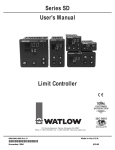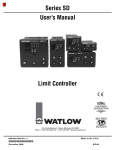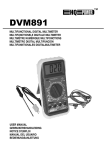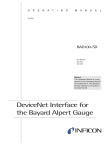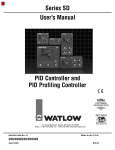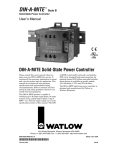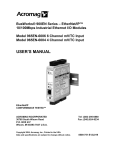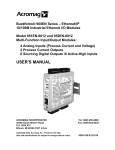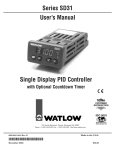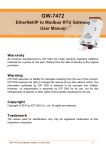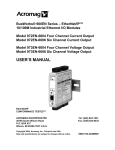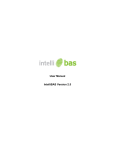Download Operation Manual 06/2005
Transcript
Series SD6 PID with DeviceNet (Addendum) Watlow’s Series SD6 with DeviceNet offers excellent control and application flexibility in a 1/16th DIN panel mount package. The Series SD6 with DeviceNet has successfully passed the rigorous testing requirements of ODVA and is also SEMI-SIG compliant. Keys and Display Diagnostic Indicator Lights Provide operating and diagnostic information about the module (MOD) and network (NET). SD6C-XXXA-DXXX shown. Up and Down Keys In the Home Page, adjusts the set point. This single-channel controller includes a universal sensor input with two outputs that can be configured as heat, cool, or alarm. The DeviceNet communications interface is supplied with either of two standard connectors, a closed style M12 (Semi-SIG compliant) or an open style connector. The Series SD6 with DeviceNet is only available with one or two outputs. In other pages, changes the upper display to a higher or lower value. Ordering Information and Model Numbers S D 6 __ Advance Key Advances the lower display through parameter prompts. __ __ __ A - D __ __ __ Control Type C = PID Control L = Limit Control R = Ramping Power Supply H = 100 to 240VÅ (ac) L = 24 V‡ (ac/dc) Table 1. Module Status (MOD) Indicator Light Indicator Light Description Off No power is applied to the device. Flashing Green-Red The device is performing a self-test. Flashing Red The controller is in Auto mode and an input error condition [Er;in] exists. This indication does not occur if the controller is in the Manual mode when an input error occurs. Red A checksum error [Er;CS] has occurred. Green The device is operating normally. Output 1 C = Switched dc K = SSR, Form A, 0.5 A F = Universal process J = Mechanical relay, Form A, 2 A Table 2. Network Status (NET) Indicator Light Output 2 A = None C = Switched dc K = SSR, Form A, 0.5 A J = Mechanical relay, Form A, 2 A DeviceNet Communications Indicator Light Description Off The device is not online. The device has not completed the duplicate MAC ID test yet. The device may not be powered. Look at Table 1, Module Status Indicator Light. Green The device is online and has connections in the established state. For a Group 2 Only device it means that the device is allocated to a Master. Red Failed communication device. The device has detected an error that has rendered it incapable of communicating on the network (duplicate MAC ID or Bus-off). Flashing Green The device is online, but no connection has been allocated or an explicit connection has timed out. Flashing Red A poll connection has timed out. N = Open style connector S = Closed style M12 connector (Semi-SIG compliant) Display Colors and Custom Options RG = Red Green RR = Red Red XX = Custom options, special overlays, etc. 0600-0041-0015 Infinity Key Returns to the Home Page. Rev D June 2005 This document is available as an Adobe Acrobat PDF file at www.watlow.com; search on “SD6 DeviceNet”. Dimensions Series SD6 open style connector Back Left Side Series SD6 closed style M12 connector, (Semi-SIG compliant) Back Left Side Switch Label Node Address Switches Set the controller’s MAC ID with the top two rotary switches on the side of the case. Set the most significant digit (MSD) with the top switch and the least significant digit (LSD) with the middle switch. For example, to set the address to 23, set the MSD to 2 and the LSD to 3. If the switch is set to“PGM”, the last node address at power down is used. Data Rate Switch Set the Data Rate switch (below the address switches) to the network data rate. If the switch is set to “PGM”, the last baud rate at power down is used. Communications Setup (0 - 63) can be selected from the front panel (Setup Menu) or via the software. The factory default values are as follows: Baud Rate = 125KB Address = 63 Closed style (M12 connector) only (SD6X-XXXA-DSXX) The three switches on the side of the unit define the address and baud rate (See picture above for closed style SD6). If the MSD switch is in the "P" (Program) position, the address will be software programmable. Likewise, if the Data Rate switch is set to "PGM" the data rate will be software programmable. On power down, the unit will always come back into the network with its last known baud rate and address. The factory default values are as follows: Baud Rate = 500KB Open style connector only (SD6X-XXXA-DNXX) Address = 63 Baud Rate (125, 250, 500KB) and Node Address or MAC ID Pinout Table 3. DeviceNet Connectors Open style Closed (M12) style Pin Open style Pin M12 Closed style Signal Black 3 V- Blue 5 CAN_L Negative side of the DeviceNet bus Grey (bare) 1 Drain Shield interconnect White 4 CAN_H Positive side of the DeviceNet bus Red 2 V+ Function DeviceNet power return DeviceNet power DeviceNet Communications This appendix describes the DeviceNet protocol as it is implemented in the Series SD6 controller. It primarily describes the objects and attributes accessible via the DeviceNet protocol. It may be necessary to refer to the DeviceNet specification as a compliment to the information found here. Addressing All data is referenced based upon a four-part definition: Node (MAC ID) + Class + Instance + Attribute. Table 4. Four Components to an Address, with Ranges DeviceNet Overview Node Address (MAC ID) [0 to 63] The SD6 controller supports the object-based modeling used in the DeviceNet concepts. This product is configured as a Group 2 Only Slave device using the Predefined Master/Slave Connection Set. Class ID Instance ID Attribute ID [1 to 255] [0 to 255] [1 to 255] There are two main categories of objects, DeviceNet Objects and Application Objects. DeviceNet objects handle what is necessary for networking and communications. Application Objects have access to the SD6 controller's parameters and data. Data Types The descriptions of attributes in the following sections includes the data type for each. Table 5 lists and describes these data types. Table 5. Descriptions of Elementary Data Types Data Type Name Data Type Description BOOL Logical Boolean with values TRUE and FALSE BYTE Bit string — 8 bits EPATH DeviceNet path segments INT Signed 16-bit integer value SHORT_STRING Character string (1 byte per character, 1 byte length indicator) UDINT Unsigned 32-bit integer value UINT Unsigned 16-bit integer value USINT Unsigned 8-bit integer value WORD Bit string — 16 bits Watlow Series SD6 PID with DeviceNet ■ 3 ■ Group 2 Only Server Electronic Data Sheet (EDS) A slave (server) device that is UCMM incapable and must use the Predefined Master/Slave Connection Set to establish communications (at a minimum, the Predefined Master/Slave Explicit Messaging Connection must be supported). A Group 2 Only device can transmit and receive only those identifiers defined by the Predefined Master/Slave Connection Set (reference DeviceNet Spec., Vol. 1, Sec. 2). The EDS allows a configuration tool to automate the device configuration process. The EDS specification provides an open standard for device configuration and compatibility among all DeviceNet products. (Refer to the DeviceNet Specification, Vol. 1, Chapter 4). You can obtain a copy of the EDS at www.watlow.com and search on keywords SD EDS, request a copy by sending an e-mail to [email protected] or by calling an Application Engineer at +1 (507) 494-5656 between 7 a.m. and 5 p.m. Central Standard Time (CST). Master/Slave Connections The SD6 supports the Predefined Master/Slave Connection Set (refer to DeviceNet Specification, Vol. 1, Sec. 7). The general model calls for the utilization of an Explicit Messaging Connection to manually create and configure Connection Objects within each connection end-point. This chapter uses the general model as a basis for the definition of a set of connections that facilitate communications typically seen in a master-slave relationship. These Connections are referred to collectively as the Predefined Master/Slave Connection Set. The master is the device that gathers and distributes I/O data for the process controller. Slaves are the devices from which the master gathers I/O data and to which the master distributes I/O data. The master “owns” the slaves whose MAC IDs appear in its scan list. To determine with what slaves it will communicate, the master examines its scan list and sends commands accordingly. Except for the Duplicate MAC ID Check, a slave cannot initiate any communication before being told by the master to do so. DeviceNet Objects The following sections describe the standard DeviceNet objects and the SD6-specific application objects. Identity Object Class Code: 01hex The Identity object provides identification information for the device. This includes the device manufacturer, product name, product type, serial number and revision. Refer to the DeviceNet Specification (Vol. II, Sec. 6-2) for complete requirements. Status Attribute – This is a bit field that represents the current status of the device. Two of the bits in the Status attribute, the Minor Recoverable Fault and Major Recoverable Fault bits, shall never be set. In accordance with the semiconductor industry standard, all module level faults are considered to be unrecoverable faults. Table 6. Identity Object Revision History Revision Description 01 Initial Release Table 7. Identity Object Class Attributes Number Access Rule Namer Watlow Series SD6 PID with DeviceNet Name DeviceNet Data Type Description of Attribute Semantics of Values ■ 4 ■ Table 8. Identity Object Instance Attributes Attribute # Access Rule Name DeviceNet Data Type Description of Attribute Semantics of Values 1 Get Vendor ID UNIT Identification of each vendor by number. This is Vendor ID 153. See “Semantics” DeviceNet Spec, Vol. II, Sec. 6-2.2 2 Get Product Type UNIT Identification of general type of product. This is Type 0. See “Semantics” DeviceNet Spec, Vol. II, Sec. 6-2.2 3 Get Product Code UNIT WATLOW SD6-DN, CODE IS 105 See “Semantics” DeviceNet Spec, Vol. II, Sec. 6-2.2 WATLOW SD6-DS, CODE IS 104 4 Get Revision STRUCT of: Revision of the item the Identity Object represents See “Semantics” DeviceNet Spec, Vol. II, Sec. 6-2.2 5 Get Status WORD Summary status of device See “Semantics” DeviceNet Spec, Vol. II, Sec. 6-2.2 6 Get Serial Number UDINT Serial number of device See “Semantics” DeviceNet Spec, Vol. II, Sec. 6-2.2 Set in accordance with a Watlow manufacturing guidelines. 7 Get Product Name SHORT_STRING Class Services: NONE Instance Services: • RESET (O,1) GET ATTRIBUTE SINGLE DeviceNet Object Class Code: 03hex The DeviceNet Object is used to provide the configuration and status of a physical attachment to DeviceNet. The MACID attribute provides the network address for the device. If the rotary switches used to specify the device MACID are set to a valid MACID, i.e. a value from 0 to 63, the MACID attribute shall have Get Only access. If the rotary switches are set to the programmable mode, the MACID attribute shall have Get and Set access. The Baud Rate attribute specifies the data rate for the device. If the rotary switch used to set the data rate specifies a valid data rate, i.e. 125, 250, or 500K Baud, the Baud Rate attribute shall have Get Only access. If the rotary switches are set to the software programmable mode, the MACID shall have Get and Set access. Watlow Series SD6 PID with DeviceNet Human readable ID: “Watlow Series SD6” See “Semantics” DeviceNet Spec, Vol. II, Sec. 6-2.2 The Allocate Master/Slave Connection Set service of the DeviceNet object shall be a required service for all devices. This implies a requirement that all devices are Group 2 devices on the DeviceNet network. Additionally, all devices shall support, as a minimum, the Explicit connection and the I/O Poll connection in the Master/Slave connection set. The Release Master/Slave Connection Set service of the DeviceNet object shall be a required service. Refer to the DeviceNet Specification (Vol. I, Sec. 5-5) for complete requirements. Table 9. DeviceNet Object Revision History Revision Description 01 Initial Release 02 Modification of Baud Rate Attribute Behavior ■ 5 ■ Table 10. DeviceNet Object Class Attributes Attribute # Access Rule Name DeviceNet Data Type Description of Attribute Semantics of Values 1 Get Revision UINT Revision of this object The revision level of this object. This is now at 2. Table 11. DeviceNet Object Instance Attributes Attribute # Access Rule Name DeviceNet Data Type Description of Attribute Semantics of Values 1 Get/Set* MACID USINT Node Address Range 0.. 63 2 Get/Set* Baud Rate USINT Baud Rate Range 0.. 2 4 Get Bus-Off Counter USINT Number of times CAN went to the bus-off state Range 0.. 255 5 Get Allocation Information STRUCT of: Range 0.. 63, 255 Allocation Choice Byte BYTE See Vol. I, Section 5-5.4.2. MAC ID of Master (from Allocate) Modified via Allocate only USINT Master’s MAC ID An input will produce data on the network and an output will consume data from the network. Class Services: GET ATTRIBUTE SINGLE Instance Services: *SET ATTRIBUTE SINGLE (when MACID or BAUD RATE in PRG MODE), GET ATTRIBUTE SINGLE, ALLOCATE M/S CONNECTION SET, RELEASE M/S CONNECTION SET. The term “Static” implies: assemblies with member lists defined by the device profile or by the manufacturer of the product. The Instance number, number of Members, and member list are fixed. Assembly Object – “Static” Table 12. Assembly Object Revision History Class Code: 04hex The Assembly Object binds attributes of multiple objects, which allows data to or from each object to be sent or received over a single connection. Assembly objects can be used to bind input data or output data. The terms “input” and “output” are defined from the network’s point of view. Revision Description 01 Initial Release 02 Class-specific Service Code 4B and 4C obsolete Table 13. Assembly Object Instance Attributes Attribute # Access Rule Name DeviceNet Data Type Description of Instance Semantics of Values 3 Get/Set Data Array of BYTES See description below See description below Instance # Access Rule Name DeviceNet Data Type Description of Instance Semantics of Values 100 Get/Set Poll Output LONG + USINT Poll Output See Poll output in section 6.2.4 101 Get Poll Input USINT + LONG + USINT + USINT Poll Input See Poll input in section 6.2.4 Watlow Series SD6 PID with DeviceNet ■ 6 ■ Poll Connection The poll connection allows the master to write set point and process value in one connection. It also allows the reading of all process value, set point and alarm status. Table 14. Static Input – Instance 101 in the Assembly Object - 7 bytes Byte(s) Parameter and Description Size of Data Range 0 Exception Status Byte - Byte reserved for future use. USINT Always returns a value of zero. 1-4 Process Value- Actual value of process input DINT -1999.000 to 9999.000 5 Alarm Status - Indicates when USINT alarm outputs are in alarm condition. For each bit: Breakdown of byte: Bit 0: alarm low 1 status Bit 1: alarm high 1 status Bit 2: alarm low 2 status Bit 3: alarm high 2 status Bit 4 to bit 7: unused (1) Alarm 6 Control Mode - USINT Breakdown of byte: Bit 0: monitor the auto / manual status. Bit 1 to bit 7: unused (0) None (0) Auto mode (1) Manual mode Table 15. Static Output – Instance 100 in the Assembly Object - 5 bytes Byte(s) Parameter and Description Size of Data 0-3 Closed Loop Set Point - Control DINT set point used in the auto mode 4 Control Modes Breakdown of byte: Range -1999.000 to 9999.000 USINT Bit 0: Selects whether the controller is in the auto or manual mode. (0) Auto mode Bit 1: Selects whether the set point adjustment is done via the SD front panel or through DeviceNet (0) DeviceNet Bit 2: Selects whether Auto/Manual mode selection is done via the SD front panel or through DeviceNet. (0) DeviceNet Bit 3 to Bit 7: Not used N/A Watlow Series SD6 PID with DeviceNet (1) Manual mode (1) SD front panel (1) SD front panel ■ 7 ■ Class Services: NONE Instance Services: • 0x0E GET ATTRIBUTE SINGLE • 0x10 SET ATTRIBUTE SINGLE Additional Poll Connection information: • In the event of the input error, a valid process value reading is no longer available. The poll connection will return a value of 9999.999 for the process value while the error condition exists. • Bit 1 and bit 2 of byte 4 in the output poll connection select whether set point and auto / manual mode values are changed from the SD’s front panel or else over DeviceNet through the poll connection. Setting the bit to “zero” will relinquish control of the parameter to the DeviceNet master device (typically the master is a PLC). Setting the bit to “one” will retain control of the parameter locally at the front panel of the Series SD controller. If there is a loss of communications, control of auto / manual mode and adjustment of set point will automatically return to the Series SD front panel regardless of the settings of byte 4 in the output poll connection. Connection Object Class Code: 05hex The Connection Class allocates and manages the internal resources associated with both I/O and Explicit Messaging Connections. The specific instance generated by the Connection Class is referred to as a Connection Instance or a Connection Object. A Connection Object within a particular module actually represents one of the end-points of a Connection. It is possible for one of the Connection end-points to be configured and “active” (e.g., transmitting) without the other end-point(s) being present. Connection Objects are used to model the communication specific characteristics of a particular application-toapplication relationship. A specific Connection Object Instance manages the communication-specific aspects related to an end-point. Watlow Series SD6 PID with DeviceNet ■ 8 ■ Explicit Connection The Explicit Connection Object defines the configuration for the Explicit connection to the device. The Explicit Connection object is an instance of the Connection Object defined in the DeviceNet Specification. All devices that are compliant with the DeviceNet Specification must support at least one instance of the Connection object with a connection type of Explicit. I/O Connection I/O Connection objects define the configuration for the I/O connections to the device. Each I/O Connection object is an instance of the Connection object defined in the DeviceNet Specification. All devices must be Group 2 devices and must support, as a minimum, the I/O Poll connection in the Master/Slave connection set. Watchdog Timeout Action Attribute defines the action performed by the I/O Connection object in the event the Inactivity/watchdog Timer for the connection expires. For the I/O Connection object, Auto Reset shall be an invalid value for the Watchdog Timeout Action attribute. (ref. SIG Specification sec. 4.1.5.1.1) Produced Connection Path Attribute defines the Application object class, instance, and attribute that produces data over the I/O connection. For all I/O connections, the Produced Connection Path shall be a Logical Segment, as defined in the DeviceNet Specification, and shall point to the Data Attribute of an Assembly object. The behavior of the device shall be such that, if the Produced Connection Path attribute is modified, the Produced Connection Size Attribute shall be modified internally to accurately reflect the size of the assembly produce by the I/O connection. For all I/O connection objects in the Master/Slave Connection Set, if the Produced Connection Path attribute is modified, the new attribute value shall be saved in Non-Volatile (NV) memory and shall be the default value when the connection is allocated. (ref. SIG Specification sec. 4.1.5.1.2). Produced Connection Size Attribute specifies the maximum number of data bytes produced over the I/O connection. The Produced Connection Size attribute shall have Get Only access for all I/O connection objects. The Produced Connection Size attribute shall accurately reflect the size of the assembly produced over the I/O connection. (ref. SIG Specification sec. 4.1.5.1.3). Consumed Connection Path Attribute defines the Application object class, instance, and, optionally, attribute that consumes data received over the I/O connection. For all I/O connections over which the device is the Server (as specified by the Direction field of the Transport Class Trigger attribute), then special requirements as defined in the Semi SIG specification shall be followed. (ref. SIG Specification sec. 4.1.5.1.4) Consumed Connection Size Attribute specifies the maximum number of data bytes consumed by the I/O connection objects. The Consumed Connection Size attribute shall accurately reflect the size of the assembly consumed by the I/O connection, as specified by the Consumed Connection Path attribute of the Data With ACK Path List attribute of the Acknowledge Handler object. (ref. SIG Specification sec. 4.1.5.1.5) Refer to the Semi SIG specification (Sec. 4.1.4/5) for Semi requirements. Refer to the DeviceNet Specification (Vol. II, Sec. 6-3) for complete requirements. Table 16. Connection Object Revision History Revision Description 01 Initial Release Table 17. Connection Object Class Attributes Attribute # Access Rule Name Watlow Series SD6 PID with DeviceNet DeviceNet Data Type Description of Attribute Semantics of Values ■ 9 ■ Table 18. Connection Object Instance Attributes Attribute # Access Rule Name DeviceNet Data Type Description of Attribute 1 Get State USINT State of the object 2 Get Instance Type USINT Indicates either I/O or Messaging 3 Get Transport Class Trigger BYTE Defines behavior of the Connection 4 Get Produced Connection ID UINT Placed in CAN Identifier Field when the Connection transmits 5 Get Consumed Connection ID UINT CAN Identifier Field value that denotes message to be received 6 Get Initial Comm Characteristics BYTE Defines the Message Group(s) across which productions and consumption associated with this Connection when it occurs 7 Get Produced Connection Size UNIT Maximum number of bytes transmitted across this Connection 8 Get Consumed Connection Size UNIT Maximum number of bytes received across this Connection 9 Get/Set Expected Packet Rate UNIT Will round up to the next 100 mSec. Increment. 12 Get/Set Watchdog Timeout Action USINT Defines how to handle Inactivity/Watchdog timeouts 13 Get Produced Connection Path Length UINT Number of bytes in the Produced Connection Path Attribute 14 Get Produced Connection Path EPATH Specifies the Application Object(s) whose data is to be produced by this Connection Object. See Appendix I, DeviceNet Specification 15 Get Consumed Connection Path Length UINT Number of bytes in the Consumed Connection Path Length 16 Get Consumed Connection Path EPATH Specifies the Application Object(s) that are to receive data consumed by this Connection Object. See Appendix I, DeviceNet Specification Watlow Series SD6 PID with DeviceNet Semantics of Values For Explicit Connection only: 1 = Auto Delete 3 = Deferred Delete ■ 10 ■ Class Services: NONE Home Object Instance Services: Class Code: 64hex • 0x0E GET ATTRIBUTE SINGLE • 0x10 SET ATTRIBUTE SINGLE The Home Object provides access to parameters used for the default display of the Series SD6. • 0x05 RESET SERVICE Table 19. Home Object Revision History Revision Description 01 Initial Release Table 20. Home Object Class Attributes Attribute # Access Rule Name DeviceNet Data Type Description of Attribute Semantics of Values 1 Get Revision UINT Revision of this object The revision level of this object (currently 1) 2 Get Max Instance UINT Max allowed Instances of this object Always 1 for this Class Watlow Series SD6 PID with DeviceNet ■ 11 ■ Table 21. Home Object Instance Attributes Attribute # Access Rule Name DeviceNet Data Type Description of Attribute Semantics of Values 100 Get Process Value DINT Current process value -1999 to 9999 (*1000), °C or units 101 Get/Set Closed Loop Set Point DINT Current closed loop set point Range is from set point low limit to set point high limit 102 Get Filtered Process Value DINT Filtered process value -1999 to 9999 (*1000), °C or units 103 Get/Set Open Loop Output Power INT Current open loop output power (used in manual mode) -100.0 to 0.0% (*100) if any output is set to cool; 0.0 to 100.0% (*100) if any output is set to heat 104 Get Current Ramp Set Point DINT Current working control set point for the ramp that is in process -1999 to 9999 (*1000), °C or units 106 Get Input Error UINT There is an analog input error (0) (1) No error Error 107 Get Alarm Low 1 Status BOOLEAN There is an alarm 1 low side alarm (0) (1) None Alarm 108 Get Alarm High 1 Status BOOLEAN There is an alarm 1 high side alarm (0) (1) None Alarm 109 Get Alarm Low 2 Status BOOLEAN There is an alarm 2 low side alarm (0) (1) None Alarm 110 Get Alarm High 2 Status BOOLEAN There is an alarm 2 high side alarm (0) (1) None Alarm Class Services: • 0x0E Setup Object GET ATTRIBUTE SINGLE Instance Services: • 0x0E GET ATTRIBUTE SINGLE • 0x10 SET ATTRIBUTE SINGLE NOTE: All successful Explicit Message Responses from a SET service will contain no data. The response will be a two-byte message containing the requester’s MAC ID and Service Code (with R/R bit set). Watlow Series SD6 PID with DeviceNet Class Code: 65hex The Setup Object provides access to parameters that define controller functions. Table 22. Setup Object Revision History Revision Description 01 Initial Release ■ 12 ■ Table 23. Setup Object Class Attributes Attribute # Access Rule Name DeviceNet Data Type Description of Attribute Semantics of Values 1 Get Revision UINT Revision of this object The revision level of this object (currently 1) 2 Get Max Instance UINT Max allowed Instances of this object 1 for this Class Table 24. Setup Object Instance Attributes Attribute # Access Rule Name DeviceNet Data Type Description of Attribute Semantics of Values 100 Get/Set Sensor Type USINT Analog input sensor type (0) (1) (2) (3) Thermocouple (default) RTD MA VOLT 101 Get/Set Thermocouple Linearization USINT Thermocouple Type (0) (1) (2) (3) (4) (5) (6) (7) (8) (9) (10) J K (default) T E N C D PTII R S B 102 Get/Set Temperature Units USINT Temperature Units (0) (1) °F °C (default) 103 Get/Set Temperature Decimal Places USINT Thermocouple/RTD precision (0) (1) 0 (default) 0.0 104 Get/Set Process Decimal Places USINT Process precision (0) (1) (2) (3) 0 (default) 0.0 0.00 0.000 105 Get/Set InfoSenseTM USINT Enables the sensor feature, which synchronizes the controller with a Watlow sensor (0) (1) NO (default) YES 106 Get/Set InfoSenseTM 1 UINT Set sensor point 1 code 0 to 999 (default is 500) 107 Get/Set InfoSenseTM 2 UINT Set sensor point 2 code 0 to 999 (default is 500) 108 Get/Set InfoSenseTM 3 UINT Set sensor point 3 code 0 to 999 (default is 500) Watlow Series SD6 PID with DeviceNet ■ 13 ■ Attribute # Access Rule Name DeviceNet Data Type Description of Attribute Semantics of Values 109 Get/Set InfoSenseTM 4 UINT Set sensor point 4 code 0 to 999 (default is 500) 110 Get/Set Process Scale Low mA UDINT Set the low scale for process input 0.00 to 20.00 mA (* 1000) (when Sensor Type set to mA, default = 4.00 mA) 111 Get/Set Process Scale Low Volts UDINT Set the low scale for process input 0.0 to 10.00 V (* 1000) (when Sensor Type set to Volt, default = 0.00 V) 112 Get/Set Process Scale High mA UDINT Set the high scale for process input 0.00 to 20.00 mA (* 1000) (when Sensor Type set to mA, default = 20.00 mA) 113 Get/Set Process Scale High Volts UDINT Set the high scale for process input 0.0 to 10.00 V (* 1000) (when Sensor Type set to Volt, default = 0.00 V) 114 Get/Set Units Scale Low DINT Set the low range for process input units -1999 to 9999 (* 1000) (default = -1999) 115 Get/Set Units Scale High DINT Set the high range for process input units -1999 to 9999 (* 1000) (default = 9999) 116 Get/Set Set Point Low Limit Thermocouple DINT Set the low range for the set point Minimum operating range (of sensor) to Set Point High Limit – 0.001 (if Sensor Type = Thermocouple, default = min. for KThermocouple) (* 1000) 117 Get/Set Set Point Low Limit RTD DINT Set the low range for the set point -328 to Set Point High Limit – 0.001 (if Sensor Type = RTD, default = 328) (* 1000) 118 Get/Set Set Point Low Limit mA and volts DINT Set the low range for the set point -1999 to Set Point High Limit – 0.001 (if Sensor Type = V or mA, default = -1999) (* 1000) 119 Get/Set Set Point High Limit Thermocouple DINT Set the high range for the set point Units Scale Low to max operating range of sensor, if Input Type = Thermocouple (default = max operating range for K-Thermocouple) (* 1000) 120 Get/Set Set Point High Limit RTD DINT Set the high range for the set point Set Point Low Limit + 0.001 to 1472, if Input Type = RTD (default = 1472) (* 1000) Watlow Series SD6 PID with DeviceNet ■ 14 ■ Attribute # Access Rule Name DeviceNet Data Type Description of Attribute Semantics of Values 121 Get/Set Set Point High Limit mA and volts DINT Set the high range for the set point Set Point Low Limit + 0.001 to 9999, if Input Type = mA or Volt (default = 9999) (* 1000) 122 Get/Set Input Filter USINT Select filtering action (1) OFF (no filtering, default) (1) Filter display only (2) Filter control input only (3) Filter both 123 Get/Set Filter Value UDINT Set the input filter value, units in seconds 0.0 to 60.0 (default = 0.0) seconds (* 1000) 124 Get/Set Output 1 Function USINT Set the output 1 function (0) OFF (1) Process Alarm (2) Deviation Alarm (3) Heat Control (default) (4) Cool Control 125 Get/Set Control Method 1 USINT Set the output 1 control type Only used with PID control (1) Fixed Timed Base (default) (1) Variable Time Base 126 Get/Set Fixed Time Base 1 USINT Set the time base for fixed time based control 1.0 to 60.0 if Output 1 is a mechanical relay 0.1 to 60.0 if Output 1 is not a mechanical relay Defaults: 20.0 mechanical relay 5.0 solid-state relay 1.0 switched DC 127 Get/Set Power Limit 1 UINT Set the maximum power output for a control output 0.0 to 100% (default = 100%) 128 Get/Set Output Power Scale Low 1 USINT Set the low end of the range within which the output will scale 0 to 100% (default = 0) 129 Get/Set Output Power Scale High 1 USINT Set the high end of the range within which the output will scale 0 to 100% (default = 100) 130 Get/Set Output Non-linear Function 1 USINT Select a non-linear output curve to match the response of your system (0) OFF (default) (1) Curve 1 (2) Curve 2 131 Get/Set Analog Output 1 Units USINT Set the analog output units (0) Milliamperes (default) (1) Volts 132 Get/Set Analog Output 1 Low Scale mA UDINT Set the low scale for analog outputs 0.00 to 20.00 mA if output is set to mA (default = 0.00) (* 1000) Watlow Series SD6 PID with DeviceNet ■ 15 ■ Attribute # Access Rule Name DeviceNet Data Type Description of Attribute Semantics of Values 133 Get/Set Analog Output 1 Low Scale volts UDINT Set the low scale for analog outputs 0.00 to 10.00 V if output is set to Volts (default = 0.00) (* 1000) 134 Get/Set Analog Output 1 High Scale mA UDINT Set the high scale for analog outputs 0.00 to 20.00 mA if output is set to mA (default = 20.00 mA) (* 1000) 135 Get/Set Analog Output 1 High Scale volts UDINT Set the high scale for analog outputs 0.0 to 10.00 V if output is set to Volts (default = 10.00 V) (* 1000) 136 Get/Set Output 2 Function USINT Set the output 2 function (0) OFF (1) Process Alarm (2) Deviation Alarm (3) Heat Control (default) (4) Cool Control 137 Get/Set Control Method 2 USINT Set the output 2 control type Only used with PID control (0) Fixed Timed Base (default) (1) Variable Time Base 138 Get/Set Fixed Time Base 2 UDINT Set the time base for fixed time based control 1.0 to 60.0 if Output 2 is a mechanical relay 0.1 to 60.0 if Output 2 is not a mechanical relay (* 1000) Defaults: 20.0 mechanical relay 5.0 solid-state relay 1.0 switched DC 139 Get/Set Power Limit 2 UINT Set the maximum power output for a control output. 1.0 to 100.0% (default = 100.0%) 140 Get/Set Output Power Scale Low 2 UINT Set the low end of the range within which the output will scale. 0 to 100% (default = 0) 141 Get/Set Output Power Scale High 2 UINT Set the high end of the range within which the output will scale. 0 to 100% (default = 100) 142 Get/Set Output Non-linear Function 2 USINT Select a non-linear output curve to match the response of your system. (0) OFF (default) (1) Curve 1 (2) Curve 2 143 Get/Set Alarm 1 Hysteresis UDINT Set the hysteresis for an alarm. This determines how far into the safe region the input needs to move before the alarm can be cleared. 1.0 to 999.0 (* 1000) (default = 1.0) 144 Get/Set Alarm 1 Logic BOOLEAN Select the alarm output condition in the alarm state. (0) Closed on alarm (default) (1) Open on alarm Watlow Series SD6 PID with DeviceNet ■ 16 ■ Attribute # Access Rule Name DeviceNet Data Type Description of Attribute Semantics of Values 145 Get/Set Alarm 1 Latching BOOLEAN Turn alarm latching on or off. (0) OFF (default) (1) ON 146 Get/Set Alarm 1 Silencing BOOLEAN Turn alarm silencing on or off. (0) No silencing (default) (1) Silencing 147 Get/Set Alarm 1 Message BOOLEAN Display an alarm message when an alarm is active. (0) OFF (no message) (1) ON (default) 148 Get/Set Alarm 2 Hysteresis UDINT Set the hysteresis for an alarm. This determines how far into the safe region the input needs to move before the alarm can be cleared. 1.0 to 999.0 (* 1000) (default = 1.0) 149 Get/Set Alarm 2 Logic BOOLEAN Select the alarm output condition in the alarm state. (0) Closed on alarm (default) (1) Open on alarm 150 Get/Set Alarm 2 Latching BOOLEAN Turn alarm latching on or off. (0) OFF (default) (1) ON 151 Get/Set Alarm 2 Silencing BOOLEAN Turn alarm silencing on or off. (0) No silencing (default) (1) Silencing 152 Get/Set Alarm 2 Message BOOLEAN Display an alarm message when an alarm is active. (0) OFF (no message) (1) ON (default) 153 Get/Set Units of Measurement BOOLEAN Set the type of units used for the PID control parameters. (0) US (default) (1) SI 154 Get/Set Input Error Latching BOOLEAN Turn the input error latching on or off. (0) OFF (default) (1) ON 155 Get/Set Input Error Failure Mode USINT Set the input error failure mode when an error is detected and the control changes to manual mode. (0) OFF (0% power) (1) Bumpless (current power level, default) (2) Manual (fixed power level) 156 Get/Set Input Error Power INT Set the manual power level when an input error causes a change to manual mode. -100.0 to 100.0% Watlow Series SD6 PID with DeviceNet ■ 17 ■ Attribute # Access Rule Name DeviceNet Data Type Description of Attribute Semantics of Values 157 Get/Set Active Displays USINT Select which display are active. (0) Both displays (default) (1) Lower display only (2) Upper display only 158 Get/Set Ramping Mode USINT Select when the control set point ramps to the defined end set point. (0) OFF (default) (1) Ramps on start-up (2) Ramps on any set point change 159 Get/Set Ramp Scale BOOLEAN Select the scale of the ramp rate. (0) Degrees / hour (default) (1) Degrees / minute 160 Get/Set Ramp Rate UDINT Set the rate for the set point ramp. 0 to 9999 (* 1000) (default = 100) 161 Get/Set Lockout USINT Set the security level for the user interface. (0) No Lockout (default) (1) Set Point, Auto/Manual, Alarms, only (2) Set Point, Auto/Manual, only (3) Set Point only (4) Full Lockout 162 Get/Set Alarm Acknowledge 1 BOOLEAN Alarm acknowledge for output 1. (0) No (1) Yes 163 Get/Set Alarm Acknowledge 2 BOOLEAN Alarm acknowledge for output 2. (0) No (1) Yes 164 Get/Set AC Line Frequency BOOLEAN Sets the frequency of the applied AC line source (0) - 60 (default) (1) - 50 165 Get/Set Profile Type BOOLEAN Sets the profile ramp to time based or rate based (0) - time based (default) (1) - ramp based 166 Get/Set Profile Start BOOLEAN Selects where the profile begins the starting set point, current static set point or process temperature. (0) - set point (default) (1) - process 167 Get/Set Guaranteed Soak Deviation Enable BOOLEAN Enables the guaranteed soak deviation function in profiles (0) - disabled (default) (1) - enabled 168 Get/Set Guaranteed Soak Deviation Value UDINT Sets the value of deviation allowed 1 to 999 (*1000) (default = 1) 169 Get/Set Process Scale Low mV UDINT Set the low scale for process input 0.00 to 50.00 mV (*1000) (when Sensor Type set to mV, default = 0.00 mV) Watlow Series SD6 PID with DeviceNet ■ 18 ■ Attribute # Access Rule Name DeviceNet Data Type Description of Attribute Semantics of Values 170 Get/Set Process Scale High mV UDINT Set the high scale for process input 0.00 to 50.00 mV (*1000) (when Sensor Type set to mV, default = 50.00 mV) 171 Get/Set Process Input Low error mA INT Sets the low process value that will cause an error to occur for the process input -1.00 to 10.00 mA (*100) (Default = -1.00 mA) 172 Get/Set Process Input Low error Volts INT Sets the low process value that will cause an error to occur for the process input -1.00 to 5.00 V (*100)(Default = -1.00 V) 173 Get/Set Process Input Low error mV INT Sets the low process value that will cause an error to occur for the process input -1.00 to 25.00 mV (*100) (Default = -1.00 mV) 174 Get/Set Process Input High error mA UINT Sets the high process value that will cause an error to occur for the process input 10.00 to 21.00 mA (*100) (Default = 21.00 mA) 175 Get/Set Process Input High error Volts UINT Sets the high process value that will cause an error to occur for the process input 5.00 to 11.00 V (*100) (Default = 11.00V) 176 Get/Set Process Input High error mV UINT Sets the high process value that will cause an error to occur for the process input 25.00 to 51.00 mV (*100) (Default = 51.00mV) 177 Get/Set Output 1 Retransmit Source BOOLEAN Set the control variable that the retransmit signal represents (0) - Process (default) (1) - Set Point 178 Get/Set Output 1 Retransmit Low Scale DINT Set the low scale for the retransmit output -1999.0 to 9999.0 (*1000) (Default = 0) 179 Get/Set Output 1 Retransmit High Scale DINT Set the high scale for the retransmit output -1999.0 to 9999.0 (*1000) (Default = 500) 180 Get/Set Output 1 Retransmit Offset DINT Set the high scale for the process output -999.0 to 999.0 (*1000) (Default = 0) 181 Get/Set RTD Linearization USINT RTD type (0) DIN (default) (1) Unused 1 (2) Unused 2 Watlow Series SD6 PID with DeviceNet ■ 19 ■ Class Services: • 0x0E Operational Object GET ATTRIBUTE SINGLE Class Code: 66hex Operational Object Instance Services: • 0x0E GET ATTRIBUTE SINGLE • 0x10 SET ATTRIBUTE SINGLE The Operational Object access parameters used during normal day-to-day operation. Table 25. Revision History NOTE: All successful Explicit Message Responses from a SET service will contain no data. The response will be a two-byte message containing the requester’s MAC ID and Service Code (with R/R bit set). Revision Description 01 Initial Release Table 26. Operational Object Class Attributes Attribute # Access Rule Name DeviceNet Data Type Description of Attribute Semantics of Values 1 Get Revision UINT Revision of this object The revision level of this object (currently 1) 2 Get Max Instance UINT Max allowed Instances Always 1 for this Class Table 27. Operational Object Instance Attributes Attribute # Access Rule Name DeviceNet Data Type Description of Attribute Semantics of Values 100 Get/Set Calibration Offset DINT Offset the input reading. -999 to 999 (x 1000) (default = 0) 101 Get/Set Autotune BOOLEAN Start an Autotune. (0) OFF (default) (1) ON 102 Get/Set Auto-Manual Mode BOOLEAN Set the control mode. (0) Auto (default) (1) Manual 103 Get Power Heat UINT Displays the current heat control power. 0.0 to 100.0% 104 Get Power Cool UINT Displays the current cool control power. 0.0 to 100.0% 105 Get/Set Heat Control Method USINT Set the heat control method. (0) OFF (1) PID (default) (2) ON/OFF Watlow Series SD6 PID with DeviceNet ■ 20 ■ Attribute # Access Rule Name DeviceNet Data Type Description of Attribute Semantics of Values 106 Get/Set Proportional Band Heat Temperature UDINT Set the proportional band for the heat outputs. 1 to 999°C (x1000), if Sensor Type is set to Thermocouple or RTD. (default = 25°C) 107 Get/Set Proportional Band Heat Process UDINT Set the proportional band for the heat outputs. 0.001 to 999.999 units, if Sensor Type is set to mA or Volt. (default = 25.000 units) 108 Get/Set Integral Heat UDINT Set the PID integral in minutes per repeat for the heat outputs. 0.00 to 99.99 (* 1000) minutes per repeat. 0.00 = disabled (default = 0.00) 108 Get/Set Reset Heat UDINT Set the PID rate time in minutes for the heat outputs. 0.00 to 99.99 (* 1000) minutes per repeat. 0.00 = disabled (default = 0.00) 109 Get/Set Derivative Heat UDINT Set the PID derivative time in minutes for the heat outputs. 0.00 to 9.99 (* 1000) minutes 0.00 = disabled (default = 0.00) 109 Get/Set Rate Heat UDINT Set the PID rate time in minutes for the heat outputs. 0.00 to 9.99 (* 1000) minutes 0.00 = disabled (default = 0.00) 110 Get/Set Dead Band Heat UDINT An offset of the heating proportional band from the set point. 0 to 999 (default = 0) 111 Get/Set Heat Hysteresis Temperature UDINT Set the control switching hysteresis for ON/OFF control. This determines how far into the ON region the input needs to move before the output actually turns on. 1 to 999 degrees, if Sensor Type is set to Thermocouple or RTD (default = 1.0) 112 Get/Set Heat Hysteresis Process UDINT Set the control switching hysteresis for ON/OFF control. This determines how far into the ON region the input needs to move before the output actually turns on. 0.000 to 999.999 units, if Sensor Type is set to mA or Volt. (default = 1.000) 113 Get/Set Cool Control Method USINT Set the cool control method. (0) OFF (1) PID (default) (2) ON/OFF Watlow Series SD6 PID with DeviceNet ■ 21 ■ Attribute # Access Rule Name DeviceNet Data Type Description of Attribute Semantics of Values 114 Get/Set Proportional Band Cool Temperature UDINT Set the proportional band for the Cool outputs. 1 to 999°C (* 1000), if Sensor Type is set to Thermocouple or RTD. (default = 25°C) 115 Get/Set Proportional Band Cool Process UDINT Set the proportional band for the Cool outputs. 0.001 to 999.999 units, if Sensor Type is set to mA or Volt. (default = 25.000 units) 116 Get/Set Integral Cool UDINT Set the PID integral in minutes per repeat for the Cool outputs. 0.00 to 99.99 (* 1000) minutes per repeat. 0.00 = disabled (default = 0.00) 116 Get/Set Reset Cool UDINT Set the PID reset in repeats per minute for the Cool outputs. 0.00 to 99.99 (* 1000) repeats per minute. 0.00 = disabled (default = 0.00) 117 Get/Set Derivative Cool UDINT Set the PID derivative time in minutes for the Cool outputs. 0.00 to 9.99 (* 1000) minutes 0.00 = disabled (default = 0.00) 117 Get/Set Rate Cool UDINT Set the PID rate time in minutes for the Cool output. 0.00 to 9.99 (* 1000) minutes 0.00 = disabled (default = 0.00) 118 Get/Set Dead Band Cool UDINT An offset of the Cooling proportional band from the set point. 0 to 999 (* 1000) (default = 0) 119 Get/Set Cool Hysteresis Temperature UDINT Set the control switching hysteresis for ON/OFF control. This determines how far into the ON region the input needs to move before the output actually turns on. 1 to 999 (* 1000) degrees, if Sensor Type is set to Thermocouple or RTD (default = 1.0) 120 Get/Set Cool Hysteresis Process UDINT Set the control switching hysteresis for ON/OFF control. This determines how far into the ON region the input needs to move before the output actually turns on. 0.000 to 999.999 units, if Sensor Type is set to mA or Volt. (default = 1.000) 121 Get Proportional Term UINT View the active proportional term for PID diagnostics. 0.000 to 1.000 (this value multiplied by 100 equals the percent power) Watlow Series SD6 PID with DeviceNet ■ 22 ■ Attribute # Access Rule Name DeviceNet Data Type Description of Attribute Semantics of Values 122 Get Integral Term UINT View the active integral term for PID diagnostics. 0.000 to 1.000 (this value multiplied by 100 equals the percent power) 123 Get Derivative Term UINT View the active derivative term for PID diagnostics. 0.000 to 1.000 (this value multiplied by 100 equals the percent power) 124 Get/Set Alarm 1 High Temperature DINT Set the high alarm set point. 0 to 9999 (* 1000) if Sensor Type is set to Thermocouple or RTD (default = 999) 125 Get/Set Alarm 1 High Process DINT Set the high alarm set point. -1999 to 9999 (* 1000) if Sensor Type is set to mA or Volt. (default = 1500) 126 Get/Set Alarm 1 Low Temperature DINT Set the low alarm set point. -1999 to 0 (* 1000) if Sensor Type is set to Thermocouple or RTD (default = -999) 127 Get/Set Alarm 1 Low Process DINT Set the low alarm set point. -1999 to 9999 (* 1000) if Sensor Type is set to mA or Volt. (default = 32) 128 Get/Set Alarm 2 High Temperature DINT Set the high alarm set point. 0 to 9999 (* 1000) if Sensor Type is set to Thermocouple or RTD (default = 999) 129 Get/Set Alarm 2 High Process DINT Set the high alarm set point. -1999 to 9999 (* 1000) if Sensor Type is set to mA or Volt. (default = 1500) Watlow Series SD6 PID with DeviceNet ■ 23 ■ Attribute # Access Rule Name DeviceNet Data Type Description of Attribute Semantics of Values 130 Get/Set Alarm 2 Low Temperature DINT Set the low alarm set point. -1999 to 0 (* 1000) if Sensor Type is set to Thermocouple or RTD (default = -999) -1999 to 9999 (* 1000) if Sensor Type is set to mA or Volt. (default = 32) 131 Get/Set Alarm 2 Low Process DINT Set the low alarm set point. -1999 to 9999 (* 1000) if Sensor Type is set to mA or Volt. (default = 32) 132 Get/Set Event Output 1 BOOLEAN Set event output 1 to an on or off state. (0) OFF (default) (1) ON 133 Get/Set Event Output 2 BOOLEAN Set event output 2 to an on or off state. (0) OFF (default) (1) ON Class Services: • 0x0E Factory/Calibration Object GET ATTRIBUTE SINGLE Class Code: 67hex Factory/Calibration Object Instance Services: • 0x0E GET ATTRIBUTE SINGLE • 0x10 SET ATTRIBUTE SINGLE The Factory/Calibration Object provides access to parameters that contain diagnostics information, calibration and restore-parameter functions. NOTE: All successful Explicit Message Responses from a SET service will contain no data. The response will be a two-byte message containing the requester’s MAC ID and Service Code (with R/R bit set). Table 28. Factory/Calibration Revision History Revision Description 01 Initial Release Table 29. Factory/Calibration Class Attributes Attribute # Access Rule Name DeviceNet Data Type Description of Attribute Semantics of Values 1 Get Revision UINT Revision of this object The revision level of this object (currently 1) 2 Get Max Instance UINT Max allowed Instances of this object Always 1 for this Class Watlow Series SD6 PID with DeviceNet ■ 24 ■ Table 30. Factory/Calibration Object Instance Attributes Attribute # Access Rule Name DeviceNet Data Type Description of Attribute Semantics of Values 100 Get Ambient Temperature DINT Displays the current calculated ambient temperature. -50.0 to 300.0°F (* 1000) 101 Get Output 1 Process Value UINT Monitors Process Output 1 value via DeviceNet 00.00 to 22.00 units 102 Get/Set Restore Factory Calibration BOOLEAN Replaces the user calibration parameters with the factory calibration parameters. (0) NO (default) (1) YES 103 Get/Set Restore User Settings BOOLEAN Restores the customer-configured settings. (0) NO (default) (1) YES 104 Get/Set Save User Settings BOOLEAN Saves the current customerconfigured settings. (0) NO (default) (1) YES 105 Get/Set Default Parameters BOOLEAN Reset all parameters to their default values. (0) NO (default) (1) YES 106 Get Output 1 Type USINT Displays the hardware type for Output 1. (0) None (1) DC/Open Col. (2) Mech. Relay (3) S.S. Relay (4) Process 107 Get Output 2 Type USINT Displays the hardware type for Output 2. (0) None (1) DC/Open Col. (2) Mech. Relay (3) S.S. Relay (4) Process 108 Get Software ID UINT Software ID number 0 to 9999 109 Get Software Build Number UINT Software built number 0 to 9999 Build Number 110 Get Serial Number UDINT Serial number 0 to 99999999 Watlow Series SD6 PID with DeviceNet ■ 25 ■ Attribute # Access Rule Name DeviceNet Data Type Description of Attribute Semantics of Values 134 Get/Set Non volatile Write BOOLEAN Write to non volatile memory (0) No (1) Yes (default) 134 Get Constant UINT Date Code 135 Get Output 2 Process Value UINT Monitors Process Output 2 value via DeviceNet 00.00 to 22.00 units 136 Get/Set Restore User Profile Settings BOOLEAN Restores the customer-configured settings. (0) NO (default) (1) YES 137 Get/Set Save User Profile Settings BOOLEAN Saves the current customerconfigured settings. (0) NO (default) (1) YES Class Services: • 0x0E Programmable Object GET ATTRIBUTE SINGLE Class Code: 68hex Programmable Object Instance Services: • 0x0E GET ATTRIBUTE SINGLE • 0x10 SET ATTRIBUTE SINGLE The Programmable Object determines what parameters appear on the Operations Page. NOTE: All successful Explicit Message Responses from a SET service will contain no data. The response will be a two-byte message containing the requester’s MAC ID and Service Code (with R/R bit set). Table 31. Programmable Object Revision History Revision Description 01 Initial Release Table 32. Programmable Class Attributes Attribute # Access Rule Name DeviceNet Data Type Description of Attribute Semantics of Values 1 Get Revision UINT Revision of this object The revision level of this object (currently 1) 2 Get Max Instance UINT Max allowed Instances of this object Always 1 for this Class Watlow Series SD6 PID with DeviceNet ■ 26 ■ Table 33. Programmable Object Instance Attributes Attribute # Access Rule Name DeviceNet Data Type Description of Attribute Semantics of Values 100 Get/set P1 USINT Programmable Parameter Location 1 See Programming Page in user’s manual. 101 Get/set P2 USINT Programmable Parameter Location 2 See Programming Page in user’s manual. 102 Get/Set P3 USINT Programmable Parameter Location 3 See Programming Page in user’s manual. 103 Get/Set P4 USINT Programmable Parameter Location 4 See Programming Page in user’s manual. 104 Get/Set P5 USINT Programmable Parameter Location 5 See Programming Page in user’s manual. 105 Get/Set P6 USINT Programmable Parameter Location 6 See Programming Page in user’s manual. 106 Get/set P7 USINT Programmable Parameter Location 7 See Programming Page in user’s manual. 107 Get/set P8 USINT Programmable Parameter Location 8 See Programming Page in user’s manual. 108 Get/set P9 USINT Programmable Parameter Location 9 See Programming Page in user’s manual. 109 Get/set P10 USINT Programmable Parameter Location 10 See Programming Page in user’s manual. 110 Get/set P11 USINT Programmable Parameter Location 11 See Programming Page in user’s manual. 111 Get/set P12 USINT Programmable Parameter Location 12 See Programming Page in user’s manual. 112 Get/set P13 USINT Programmable Parameter Location 13 See Programming Page in user’s manual. 113 Get/set P14 USINT Programmable Parameter Location 14 See Programming Page in user’s manual. 114 Get/set P15 USINT Programmable Parameter Location 15 See Programming Page in user’s manual. Watlow Series SD6 PID with DeviceNet ■ 27 ■ Attribute # Access Rule Name DeviceNet Data Type Description of Attribute Semantics of Values 115 Get/set P16 USINT Programmable Parameter Location 16 See Programming Page in user’s manual. 116 Get/set P17 USINT Programmable Parameter Location 17 See Programming Page in user’s manual. 117 Get/set P18 USINT Programmable Parameter Location 18 See Programming Page in user’s manual. 118 Get/set P19 USINT Programmable Parameter Location 19 See Programming Page in user’s manual. 119 Get/set P20 USINT Programmable Parameter Location 20 See Programming Page in user’s manual. 120 Get/set P21 USINT Programmable Parameter Location 21 See Programming Page in user’s manual. 121 Get/set P22 USINT Programmable Parameter Location 22 See Programming Page in user’s manual. 122 Get/set P23 USINT Programmable Parameter Location 23 See Programming Page in user’s manual. Class Services: • 0x0E Profiling Object GET ATTRIBUTE SINGLE Class Code: 69hex Profiling Object Instance Services: • 0x0E GET ATTRIBUTE SINGLE • 0x10 SET ATTRIBUTE SINGLE The Profiling Object provides access to parameters that contain profiling parameters. NOTE: All successful Explicit Message Responses from a SET service will contain no data. The response will be a two-byte message containing the requester’s MAC ID and Service Code (with R/R bit set). Table 34. Profiling Object Revision History Revision Description 01 Initial Release Table 35. Profiling Class Attributes Attribute # Access Rule Name DeviceNet Data Type Description of Attribute Semantics of Values 1 Get Revision UINT Revision of this object The revision level of this object (currently 1) 2 Get Max Instance UINT Max allowed Instances of this object Always 1 for this Class Watlow Series SD6 PID with DeviceNet ■ 28 ■ Table 36. Profiling Object Instance Attributes Attribute # Access Rule Name DeviceNet Data Type Description of Attribute Semantics of Values 100 Get/Set Profile Type BOOLEAN Set the profile ramp to time based or rate based (0) - Time (default) (1) - Rate 101 Get/Set Profile Start BOOLEAN Selects where the profile begins the starting set point of the profile, current static set point or current process temperature. (0) - Set Point (default) (1) - Process 102 Get/Set Guaranteed Soak Deviation Enable BOOLEAN Enables the guaranteed soak deviation function in profiles (0) - Disabled (default) (1) - Enabled 103 Get/Set Guaranteed Soak Deviation Value UDINT Set the value of deviation allowed by the guaranteed soak deviation function 1 to 999 (*1000) (default = 1) 104 Get Profile State USINT Indicates current profile status (0) - Off (default) (1) - Holding (2) - Running (3) - Pre-run check failed when starting the profile (4) - Pre-run failed when resuming the profile 105 Get Jump Count Step Enabled BOOLEAN Indicates whether a Jump Step is currently being executed (0) - Profile is not running or is running and currently not executing a Jump step (default) (1) - Profile is executing a Jump step 106 Get/Set Start File Number UINT Selects the file to start running 1 to 4 (default = 1) 107 Get/Set Start Step Number UINT Selects the profile step to be run 1 to 10 (default = 1) 108 Get/Set Profile Select USINT Selects what to do when a profile is on hold (0) - Off (1) - Resume (2) - Hold 109 Get Guaranteed Soak Deviation Message BOOLEAN Monitors guaranteed soak deviation status (0)- Disabled (default) (1)- Enabled 110 Get File Running UINT File number that is currently running 1 to 4 111 Get Step Running UINT Step number that is currently running 1 to 10 112 Get End Set Point Value DINT Set point value reached at the end of current step (Splo) to (sphi) Watlow Series SD6 PID with DeviceNet ■ 29 ■ Attribute # Access Rule Name DeviceNet Data Type Description of Attribute Semantics of Values 113 Get Hours Remaining UINT Indicates number of hours remaining in the step currently running 0 to 99 114 Get Minutes Remaining UINT Indicates number of minutes remaining in the step currently running 0 to 59 115 Get Seconds Remaining UINT Indicates number of seconds remaining in the step currently running 0 to 59 116 Get Ramp Rate UDINT Rate at which the profile changes in degrees or units per minute 0.0 to 9999.9 (*1000) 117 Get Event Output 1 status BOOLEAN Indicates Event Output 1 status (0)- OFF (1)- ON 118 Get Event Output 2 status BOOLEAN Indicates Event Output 2 status (0)- OFF (1)- ON 119 Get Wait-for Process Value DINT Profile clock waits until the process value matches the Wait-for value and continues with the step (Splo) to (sphi) 120 Get Elapsed Jump Count UDINT Number of times the profile has been through the Jump Loop Step 0 to 9999 (*1000) 121 Get Failed File Number UINT Indicates the file number that failed the Pre-Run check 1 to 4 122 Get Failed Step Number UINT Indicates the step number that failed the Pre-Run check 1 to 10 123 Get/Set Comms Temperature Units BOOLEAN This register determines the units of measure for temperature values during DeviceNet communication (0)- Fahrenheit (default) (1)- Celsius Class Services: • 0x0E Profile Program Object GET ATTRIBUTE SINGLE Class Code: 6Ahex Profile Program Object Instance Services: • 0x0E GET ATTRIBUTE SINGLE • 0x10 SET ATTRIBUTE SINGLE NOTE: All successful Explicit Message Responses from a SET service will contain no data. The response will be a two-byte message containing the requester’s MAC ID and Service Code (with R/R bit set). Watlow Series SD6 PID with DeviceNet The Profile Program Object provides access to parameters that contain profile programs. Table 37. Profile Program Object Revision History Revision Description 01 Initial Release ■ 30 ■ Table 38. Profile Program Class Attributes Attribute # Access Rule Name DeviceNet Data Type Description of Attribute Semantics of Values 1 Get Revision UINT Revision of this object The revision level of this object (currently 1) 2 Get Max Instance UINT Max allowed Instances of this object Always 1 for this Class Instances 1 through 10 are for File 1, steps 1 through 10. Instances 11 through 20 are for File 2, steps 1 through 10. Instances 21 through 30 are for File 3, steps 1 through 10. Instances 31 through 40 are for File 4, steps 1 through 10. Table 39. Profiling Object Instance Attributes Attribute # Access Rule Name DeviceNet Data Type Description of Attribute Semantics of Values 100 Get/Set Step Type USINT Selects step type (0) (1) (2) (3) (4) 101 Get/Set Target Set Point DINT Indicates ending set point value -1999 to 9999 (*1000) (default = 75) 102 Get/Set Hours UINT Hours in the step 0 to 99. (default = 0) 103 Get/Set Minutes UINT Minutes in the step 0 to 59. (default = 0) 104 Get/Set Seconds UINT Seconds in the step 0 to 59. (default = 0) 105 Get/Set Rate UDINT Indicates rate at which set point changes in degrees per minute 0 to 9999 (*1000) (default = 0) 106 Get/Set Event Output 1 BOOLEAN Selects whether output 1 is on or off during step (0) - OFF (default) (1) - ON Watlow Series SD6 PID with DeviceNet - End (default) Set Point Soak Jump Loop Link File ■ 31 ■ Attribute # Access Rule Name DeviceNet Data Type Description of Attribute Semantics of Values 107 Get/Set Event Output 2 BOOLEAN Selects whether output 2 is on or off during step (0) - OFF (default) (1) - ON 108 Get/Set Wait-for Process Enable BOOLEAN Select to enable Wait-for Process value (0) - NO (default) (1) - YES 109 Get/Set Wait-for Process value DINT Selects wait-for value before step timer starts -1999 to 9999(*1000) Default = 75 110 Get/Set Jump File UINT Selects the file which is to be jumped to 1 to 4. Default = 1 111 Get/Set Jump Step UINT Selects the step which is to be jumped to 1 to 10. Default = 1 112 Get/Set Jump Count UINT Indicates the number of time the jump is to be done. 0 to 9999. Default = 1 113 Get/Set Link File UINT Selects the file to link to. 1 to 4. Default = 1 114 Get/Set End BOOLEAN Selects the state of the control and auxilary outputs when a profile is ended (0) - Off (default) (1) - Hold Class Services: • 0x0E GET ATTRIBUTE SINGLE Instance Services: • 0x0E GET ATTRIBUTE SINGLE • 0x10 SET ATTRIBUTE SINGLE NOTE: All successful Explicit Message Responses from a SET service will contain no data. The response will be a two-byte message containing the requester’s MAC ID and Service Code (with R/R bit set). Watlow Series SD6 PID with DeviceNet ■ 32 ■
































